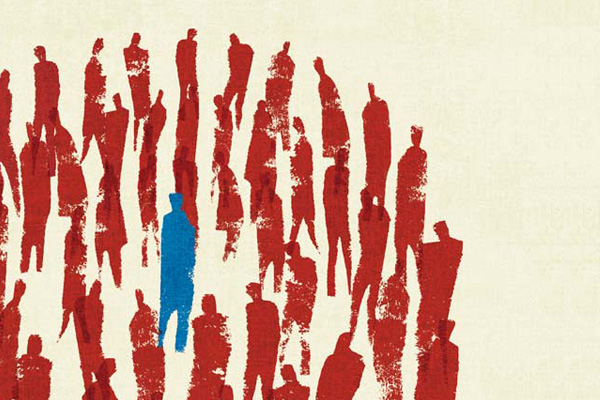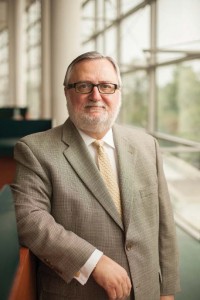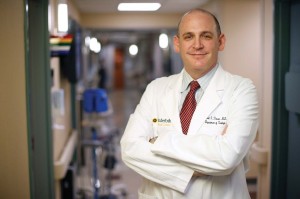Center of Attention
Prostate cancer survivors step into the spotlight to take outcomes research in a new direction
November 21, 2013 | Kathy Whitney

Illustration by Jing Jing Tsong
When Dan McCollum was diagnosed with prostate cancer 10 years ago, he asked his doctor for information about his condition and options for treatment before leaving the appointment.
The receptionist handed him a sheet of paper that had been photocopied so many times that it was hardly legible and a flimsy brochure that told him to contact the American Cancer Society for more information.
McCollum, 61, was no stranger to the disease. His grandfather, father, uncles and cousins had it, too. A year later, his brother would be diagnosed. An employee of the Eskind Biomedical Library, he had already done some research. He simply wanted more information and was surprised to learn that it was not as easy to come by as he thought.
Based on sound advice from his urologist, McCollum opted for radical surgery and did well. But, he has an adult son, and with their strong family predisposition to the disease, McCollum felt called to action.
“Why am I not doing something? I searched the Internet and there didn’t seem to be anyone in Tennessee doing anything about it, so I started the Prostate Cancer Coalition of Tennessee—an educational nonprofit,” McCollum said.
Through his work with the coalition and the Tennessee Men’s Health Report Card, McCollum met David Penson, M.D., MPH, and the two have teamed up to make sure that men have access to the information they need to make smart decisions about their prostate cancer journey.
A $1.9 million grant from the Patient-Centered Outcomes Research Institute (PCORI) will serve as the compass for taking prostate cancer care in a new direction.
The heart of the matter
“Throughout halls of academia, we are starting to rethink clinical research to some degree,” said Penson, the Paul V. Hamilton, M.D. and Virginia E. Howd Professor of Urologic Oncology. “To date, a lot of the research we’ve done has gotten away from the patient. We end up developing information that is good for providers but not good for the patients. The PCORI grant allows us to retool our ongoing research, to some degree, to make it patient-centered.”
Prostate cancer is the most common solid tumor and the second leading cause of cancer death among American men. While surgery, radiation and observation have all been deemed appropriate therapies for localized prostate cancer, many questions remain unanswered. In fact, the Agency for Healthcare Research and Quality 2008 evidence report on the comparative effectiveness of therapies for localized prostate cancer concluded that no one therapy can be considered the preferred treatment.

Dan McCollum, a cancer survivor, is chair of the patient advisory council for prostate cancer outcomes research. Photo by Daniel Dubois.
McCollum’s family illustrates how complex the issue can be. His grandfather, who was diagnosed at 87, was advised to have surgery, but he opted for the observational approach.
“He said, ‘You’ve got to be kidding. I’ve had a great life. You’re not cutting on me,’” McCollum recalled with a chuckle.
He died at age 100. McCollum’s father underwent radiation and androgen therapy and lived another 12 years, succumbing to a different disease. McCollum’s brother opted for robotic surgery.
How did the men fare? What were the side effects of their chosen treatment? How did it affect their overall health, their marriages, and their families? These are the questions that McCollum and Penson want to ask patients and then they want the answers available to newly diagnosed men.
Penson said that his three-year study, which is a continuation of an earlier one-year study known as the Comparative Effectiveness Analysis of Surgery and Radiation (CEASAR), will generate critical information that patients need to make decisions about prostate cancer treatment that reflect their personal preferences and values.
“What we do in personalized medicine is we look at genes to see how people respond to drugs we use to treat their disease. I would argue that it is just one piece of the personalization. This PCORI study is the piece that deals with people’s culture and background and personality. There’s the part that deals with the physical; this is the part that deals with the heart,” he said. “People are different even if they have similar genetic codes.”
Using an existing population-based study of 3,691 men diagnosed with prostate cancer in 2011, he and his colleagues will collect patient-reported outcomes three years after their diagnosis.
The study participants underwent a variety of treatments, including open and robotic surgery, modern radiation techniques, and active surveillance. Through the CEASAR study, he has already collected patient-reported outcomes and medical record information at baseline, six, and 12 months after diagnosis.
“By collecting three-year outcomes, the study will determine which prostate cancer treatments work best, in which patients, and in whose hands,” Penson said.
According to his grant submission, the study will specifically compare the effectiveness of contemporary surgical and radiation techniques for localized prostate cancer in terms of the six-, 12- and 36-month patient-reported outcomes and quality of life, side effects, cancer control, and treatment complications. Prior studies have identified these outcomes as the ones patients consider when choosing therapy. Researchers will also identify subgroups of patients who respond better to certain treatments than others, effectively tailoring the results of the study to the individual patient. Finally, they will explore how the effectiveness of therapy is influenced by the quality of care delivered, in hopes of aiding patients not only in choosing which treatment to receive, but which facility/provider they should use to deliver their care.
From the ground up McCollum is serving as the chair of the patient advocacy council, which comprises a group of 13 men who meet monthly to develop questions that will be most meaningful to the patients. Those questions will then be part of the PCORI study.
“We’ve lived it, so we have different questions than researchers,” McCollum said. “It just really bothered me that men could leave the doctor’s office and not know any more than they knew. It can be overwhelming to be suddenly told that you have cancer and that it needs to be taken out and you don’t really even know what they are taking out, what it does, if you need it, or if you can live without it.”
Getting a group of men to openly discuss their health on such a personal level has proven to be a bit of a challenge, but more of them are realizing the benefit of sharing their stories and compiling information. How a man feels one year after treatment can be vastly different than how he will feel three years out. This long-term approach afforded by the PCORI study offers a perspective that other studies do not.
“This is the greatest opportunity that I’ve ever witnessed for men or patient advocates to be involved from the ground up. I’ve done this type of thing before, but this is different. Dr. Penson has embraced the group. He truly wants our help,” McCollum said.

David Penson, M.D., MPH, is involving patients in every step of the research process. Photo by John Russell.
Over the next three years, Penson will involve patients in every step of the research process, from identifying the questions, to how to ask them, to analyzing the research and getting it out to patients.
“Dan understands the important questions to ask patients because he is a patient. He gets it. I haven’t been on the other side of a biopsy gun or a scalpel or radiation machine,” Penson said.
Working closely with patients in a non-clinical setting is a paradigm shift whose time has arrived, Penson said.
“As a researcher and provider, I’ve been in school forever. I’m going to bring in people who don’t know the first thing about epidemiology and biostatistics and trial design, but know about something I don’t know, which is the experience of having the disease. It’s a matter of me being able to explain the rules I have to play by as far as good science, and at the same time being open to the idea of listening to the patient and teaming up with them to make a meaningful project.”
Getting the information out to the patients in an easy-to-use format will be the next big hurdle, but Penson can envision a time in the near future when a man with newly diagnosed prostate cancer will be able to sit down at his computer and type in his age, ethnicity and details about his culture and social surroundings, and the computer will generate survival rates at five years if he opts for surgery, and his risk of being impotent or incontinent. He will be able to program in personality traits and answer questions regarding decision making style, trust in the health care system and patient support.
“The modeling and statistical background pieces are there. It’s just a matter of designing a user interface so it’s easy to use for patients,” Penson said. “If I am going to generate that information, I have to parse it out in such a way that the average person gets it. I really think that this is a wave that has been developing for a decade or more. It’s an idea in evolution.”
1 Comment
Sorry, the comment form is closed at this time.

I am so happy I volunteered to be a member of the group. It is a great thing Dan has started and Dr. Penson has followed
through. An exciting program
Comment by Jack Corn — December 3, 2013 @ 7:44 pm